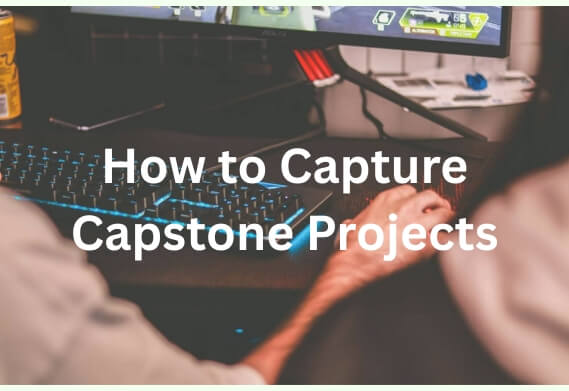Many game design capstone students aim to produce commercial-quality, polished portfolio pieces. But the reality is that few projects achieve this level of finish due to limited time and resources. This significant gap between aspiration and achievable outcome makes it difficult to effectively showcase their work and successfully transition into the competitive industry.
With the global online gaming market sitting at $208 billion and set to nearly double by 2032, the need for clear, strong documentation has never been more critical (Fortune Business Insights, 2025). Documenting the development process and final product of capstone projects is crucial. To bridge this gap, we outline an effective, two-part screen recording strategy to help you showcase your technical achievements, regardless of the game's final polish.
Why Screen Recording is Essential for Game Capstone Evaluation
Screen recording is a critical component for evaluating online game degree capstone projects because it bridges the gap between static artifacts and the dynamic nature of a game. Students pursuing the best game degrees online rely on high-quality screen capture to prove their technical proficiency and design skills to remote faculty and future employers.
Recording Provides a Complete and Verifiable Remote Assessment
-
Showcases the Real-Time Experience: You can't capture a game's feel or flow with a screenshot. A recording shows the game in action, letting evaluators see the user interface (UI), the moment-to-moment mechanics, and the overall player experience, which static files fail to convey.
-
Allows for Accurate Remote Observation: Faculty members need to verify that your game works as intended. Screen recording lets them remotely observe the actual gameplay, how the core design was implemented, and whether all technical functions are reliable.
-
Proves You Met Design Goals: The video gives clear, undeniable visual proof. It shows exactly how your final game design, its instructions, and its overall quality directly align with the capstone rubric and the original objectives you set out to achieve.
Recording Streamlines and Professionalizes the Evaluation
-
Standardizes the Review Process: Instead of relying on various live demos, a recording provides a consistent, repeatable playback for everyone. This removes ambiguity and ensures all projects are judged fairly based on the same visual evidence.
-
Facilitates Clearer Communication: Students can use the recording to easily demonstrate specific features, clearly show evaluators how to reproduce a tricky bug, and walk them through the project's most complex technical areas.
-
Creates Professional Portfolio Assets: Ultimately, these recorded videos become professional artifacts. They are crucial for gathering effective feedback, simplifying remote troubleshooting, and creating a high-quality showcase piece that you can use well beyond your course.
What Are the Best Screen Recorders for Capturing Game Footage?
The best screen recorders for capturing high-frame-rate (60 FPS) game footage without performance lag include:
1. EaseUS RecExperts
This versatile software is packed with features for content creators. It captures super-smooth, lag-free footage up to 4K at 144 FPS using hardware acceleration and even includes handy, built-in editing tools for quick polish.
Best For: Gamers and creators who need top-tier, high-resolution recording (up to 4K/144 FPS) and prefer an all-in-one app with editing and noise reduction capabilities.
Key Features
- Supports recording up to 4K and 144 FPS.
- Uses Hardware (GPU) acceleration to minimize lag and performance hits.
- Offers flexible recording: game mode, full screen, or custom area.
- Includes video editing and noise reduction tools right in the app.
Pros
- Records at 60 FPS and higher with no noticeable system lag.
- A versatile tool that combines recording and basic editing.
- Simple, user-friendly interface for all skill levels.
Cons
- Requires a paid license for full access.
2. OBS Studio (Open Broadcaster Software)
OBS is the industry standard—a powerful, free, and open-source workhorse trusted by streamers everywhere. It allows for deep customization, supports multiple input sources (webcams, screens, etc.), and achieves high-quality 60+ FPS capture using your graphics card's encoding.
Best For: Streamers and advanced users who require powerful, customizable setups, multiple simultaneous inputs, and the best free recording solution available.
Key Features
- Completely free and open-source.
- Deeply customizable options for scenes, sources, and video filters.
- Delivers stable 60 FPS or even higher-frame-rate recording.
- Features real-time video mixing and transition effects.
- Supports GPU encoding (NVENC, AMD VCE) for better performance.
Pros
- Absolutely free, with zero watermarks or time limits.
- Extremely powerful and flexible for complex broadcasts.
- Backed by a huge user community and frequent, reliable updates.
Cons
- New users may find the initial setup and customization challenging.
- Optimizing for smooth high-FPS recording often requires some technical knowledge.
3. Bandicam
Bandicam is designed for fast performance and low system impact. This lightweight recorder leverages powerful hardware acceleration (like DirectX and Vulkan) to capture fluid, high-FPS gameplay while keeping the resulting video files small and efficient.
Best For: Gamers who prioritize a lightweight program that won't strain their PC, delivers minimal lag, and produces small, highly efficient video files.
Key Features
- Simple interface and very low system resource usage.
- Superior support for various hardware accelerators.
- Captures smooth 60 FPS (or higher) using native graphics APIs like DirectX/OpenGL/Vulkan.
- Efficient compression results in noticeably smaller file sizes.
Pros
- Causes minimal to no performance lag while you play and record.
- Supports extremely high frame rates (up to 480 FPS).
- A dependable and stable choice specifically for game capture.
Cons
- The free version applies a watermark.
- The interface can feel slightly dated compared to modern alternatives.

Poindeo: The Essential Bridge from Raw Footage to Professional Capstone Presentation
While the tools listed above master the capture of raw, high-performance footage, a successful capstone project needs more than just video; it requires a visually compelling, narrated demonstration. This is where a presentation-focused, browser-based tool like Poindeo becomes essential.
Poindeo fills the critical gap between capturing your game and delivering a polished final presentation that meets high academic standards:
- Focus the Viewer with Dynamic Zoom: Raw game footage is often messy and distracting. Poindeo takes care of messy footage by allowing you to quickly drop dynamic zoom effects directly onto videos, images, and PDFs.
- Easily Merge All Your Assets and Documents: Remember, capstones demand you show more than just the game running; you need to present concept art, design documents, and visual mockups.
- Simple, Browser-Based Tool: Forget dealing with complicated desktop editing software. Students can avoid the steep learning curve, heavy hardware requirements, and installation hassles. Poindeo is a professional presentation suite that you can open and use instantly from any modern web browser.
- Create Clear, Narrated Tutorials: Poindeo supports multi-source recording, making it simple to layer your voiceover and face-cam commentary directly onto the demonstration. This effortlessly transforms your raw gameplay into an accessible, crystal-clear presentation, making it easy for you to generate high-quality screen recording tutorials for your faculty and portfolio.
The Final Polish: Securing Your Professional Portfolio
All the hard work you did, the hours spent debugging code and perfecting mechanics, give your capstone its absolute foundation. Yet, in this industry, only a top-notch presentation can deliver the crucial polish that truly defines your professional portfolio.
Don't let the game's technical complexity or minor imperfections hide your real accomplishments. A professional developer must clearly articulate and visually showcase their work. This means transforming raw footage into a polished, explanatory piece ready for your career. Take this final step now: commit to documenting your process and building the compelling portfolio piece you deserve.
